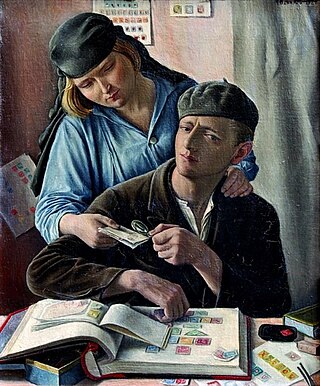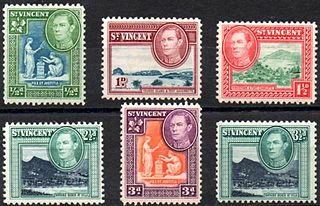
Philately is the study of postage stamps and postal history. It also refers to the collection and appreciation of stamps and other philatelic products. While closely associated with stamp collecting and the study of postage, it is possible to be a philatelist without owning any stamps. For instance, the stamps being studied may be very rare or reside only in museums.

Stamp collecting is the collecting of postage stamps and related objects. It is an area of philately, which is the study of stamps. It has been one of the world's most popular hobbies since the late nineteenth century with the rapid growth of the postal service, as a stream of new stamps was produced by countries that sought to advertise their distinctiveness through their stamps.

Postal history is the study of postal systems and how they operate and, or, the study of the use of postage stamps and covers and associated postal artifacts illustrating historical episodes in the development of postal systems. The term is attributed to Robson Lowe, a professional philatelist, stamp dealer and stamp auctioneer, who made the first organised study of the subject in the 1930s and described philatelists as "students of science", but postal historians as "students of humanity". More precisely, philatelists describe postal history as the study of rates, routes, markings, and means.

Postage stamps and postal history of Great Britain surveys postal history from the United Kingdom and the postage stamps issued by that country and its various historical territories until the present day.
The Penny Post is any one of several postal systems in which normal letters could be sent for one penny. Five such schemes existed in the United Kingdom while the United States initiated at least three such simple fixed rate postal arrangements.

The Mauritius "Post Office" stamps were issued by the British Colony Mauritius in September 1847, in two denominations: an orange-red one penny (1d) and a deep blue two pence (2d). Their name comes from the wording on the stamps reading "Post Office", which was soon changed in the next issue to "Post Paid". They are among the rarest postage stamps in the world.
The GPO Film Unit was a subdivision of the UK General Post Office. The unit was established in 1933, taking on responsibilities of the Empire Marketing Board Film Unit. Headed by John Grierson, it was set up to produce sponsored documentary films mainly related to the activities of the GPO.

Stephen Hector Taylor-Smith often known as Stephen Smith, was a pioneering Indian aerospace engineer who developed techniques in delivering mail by rocket.

The Royal Philatelic Society London (RPSL) is the oldest philatelic society in the world. It was founded on 10 April 1869 as The Philatelic Society, London. The society runs a postal museum, the Spear Museum of Philatelic History, at its headquarters in the City of London.
The Festiniog Railway Letter Service is an officially authorised service within the United Kingdom railway system for posting and transmission of letters, and under certain circumstances also delivering the letters directly to intended recipients. The service operates on the Ffestiniog Railway and the Welsh Highland Railway in North Wales and similar services are operated on the Talyllyn Railway and other heritage railways in the UK. The service was also offered until 1984 by British Railways as successors to the many constituent railway companies that had in 1891 signed an agreement with the G.P.O. and it was BR that regulated the terms and the charges in conjunction with the post office.
Barnett Freedman CBE RDI was a British painter, commercial designer, book illustrator, typographer, and lithographer.

This is a survey of the postage stamps and postal history of Gibraltar.

Saint Vincent and the Grenadines, a former British colony in the Windward Islands, has produced stamps since 8 May 1861. The stamps featured either the British monarch’s head on them or the ER monogram and crown until around 1970. The stamps were printed with just "St. Vincent" until 1992 when the stamps began to print the full country name, "St. Vincent and the Grenadines".

This is a survey of the postage stamps and postal history of Saint Helena.
Douglas N. Muir is the former Senior Curator of Philately at The Postal Museum in London, formerly the British Postal Museum & Archive and a signatory to the Book of Scottish Philatelists and the Roll of Distinguished Philatelists.

The Chinchen Collection is a collection of stamps, proofs, artwork and covers from Lundy Island donated by Barry Chinchen to the British Library Philatelic Collections in 1977 and is located at the British Library.

William Amos Scarborough Westoby M.A. (1815–1899) was an English philatelist who was one of the "Fathers of Philately" entered on the Roll of Distinguished Philatelists in 1921. His obituary in The London Philatelist stated that he had "...fairly earned the title of the Grand Seigneur of Philately." By profession, Westoby was a barrister of Lincoln's Inn.
The Muraleetharan Papers are a collection of philatelic research documents by George Muraleetharan in eleven volumes that form part of the British Library Philatelic Collections. The papers relate to British Commonwealth postage stamps including: "...the 1935 Silver Jubilee issue, the 1937 Coronation issue, the 1947 Victory or Peace issue, 1953 Coronation issue, the Royal portraits for the issues of George V, George VI and Elizabeth II, correspondence relating to security printers, the Royal Mint Archives, De La Rue Archives, and Australian issues in the Australian Archives."

Soirées musicales,, Op. 9, is a suite of five movements by Benjamin Britten, using music composed by Gioachino Rossini. The suite, first performed in 1937, derives its title from Rossini's collection of the same name, dating from the early 1830s, from which Britten drew much of the thematic material.













